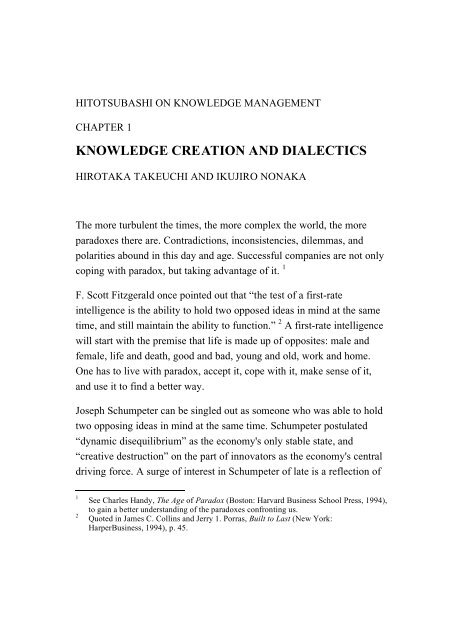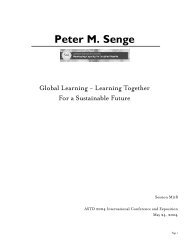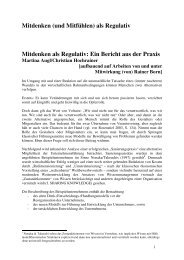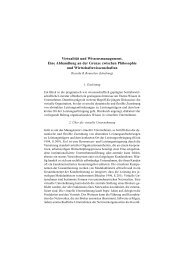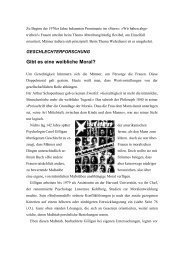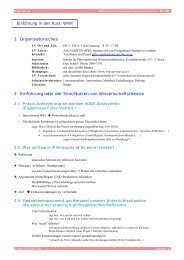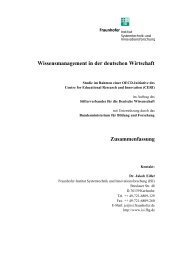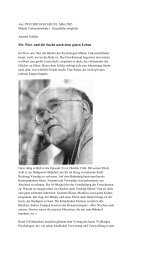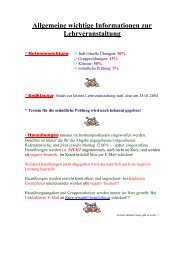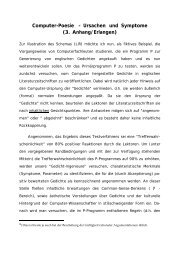KNOWLEDGE CREATION AND DIALECTICS
KNOWLEDGE CREATION AND DIALECTICS
KNOWLEDGE CREATION AND DIALECTICS
You also want an ePaper? Increase the reach of your titles
YUMPU automatically turns print PDFs into web optimized ePapers that Google loves.
HITOTSUBASHI ON <strong>KNOWLEDGE</strong> MANAGEMENT<br />
CHAPTER 1<br />
<strong>KNOWLEDGE</strong> <strong>CREATION</strong> <strong>AND</strong> <strong>DIALECTICS</strong><br />
HIROTAKA TAKEUCHI <strong>AND</strong> IKUJIRO NONAKA<br />
The more turbulent the times, the more complex the world, the more<br />
paradoxes there are. Contradictions, inconsistencies, dilemmas, and<br />
polarities abound in this day and age. Successful companies are not only<br />
coping with paradox, but taking advantage of it. 1<br />
F. Scott Fitzgerald once pointed out that “the test of a first-rate<br />
intelligence is the ability to hold two opposed ideas in mind at the same<br />
time, and still maintain the ability to function.” 2 A first-rate intelligence<br />
will start with the premise that life is made up of opposites: male and<br />
female, life and death, good and bad, young and old, work and home.<br />
One has to live with paradox, accept it, cope with it, make sense of it,<br />
and use it to find a better way.<br />
Joseph Schumpeter can be singled out as someone who was able to hold<br />
two opposing ideas in mind at the same time. Schumpeter postulated<br />
“dynamic disequilibrium” as the economy's only stable state, and<br />
“creative destruction” on the part of innovators as the economy's central<br />
driving force. A surge of interest in Schumpeter of late is a reflection of<br />
1<br />
2<br />
See Charles Handy, The Age of Paradox (Boston: Harvard Business School Press, 1994),<br />
to gain a better understanding of the paradoxes confronting us.<br />
Quoted in James C. Collins and Jerry 1. Porras, Built to Last (New York:<br />
HarperBusiness, 1994), p. 45.
our times. What is interesting to note is the fact that his postulates are the<br />
antithesis of prevailing economic theory based on the idea of equilibrium<br />
as a healthy economy's norm and on monetary and fiscal policies as the<br />
drivers of a modern economy. A first-rate mind now has the opportunity<br />
of holding two opposing views - Schumpeter's thesis and the antithesis<br />
of modern-day economics - at the same time and using them to find a<br />
better way.<br />
Living with paradox is neither comfortable nor easy. Charles -<br />
Handy described it as follows:<br />
It can be like walking in a dark wood on a moonless night. It is<br />
an eerie and, at times, a frightening experience. All sense of<br />
direction is lost; trees and bushes crowd in on you; wherever<br />
you step, you bump into another obstacle; every noise and<br />
rustle is magnified; there is a whiff of danger; it seems safer to<br />
stand still than to move. Come the dawn, however, and your<br />
path is clear; the noises are now the songs of birds and the<br />
rustle in the undergrowth is only scuttling rabbits; trees define<br />
the path instead of blocking it. The wood is a different place. 3<br />
If we can bring light to the paradoxes, then the world could look<br />
different and less threatening. In fact, that is what successful companies<br />
are doing.<br />
Corporate success has never been more fragile. Only a few<br />
companies have proven themselves capable of changing as fast as the<br />
environment around them and dealing with the complexities surrounding<br />
them. One of the main reasons that companies fail today is their<br />
tendency to kill paradoxes by sticking to old routines created by their<br />
past success.<br />
3<br />
Charles Handy (1994), p. 14.<br />
HIROTAKA TAKEUCHI <strong>AND</strong> IKUJIRO NONAKA: <strong>KNOWLEDGE</strong> <strong>CREATION</strong> <strong>AND</strong><br />
<strong>DIALECTICS</strong> (0507; p. 2 )
In stark contrast, a new breed of companies has emerged as leaders<br />
in this day and age of paradox. These companies, which we are calling<br />
“dialectic” companies, are not just passively coping with paradox. They<br />
are actively embracing opposites. They are positively cultivating<br />
contradictions. They are passionately using paradoxes as an invitation to<br />
find a better way.<br />
PARADOX <strong>AND</strong> <strong>KNOWLEDGE</strong><br />
The once-in-a-200-year shift from the Industrial Society to the<br />
Knowledge Society has changed the way we view paradox. Paradox was<br />
something to be eliminated in the Industrial Society. It went against the<br />
very essence of what Frederick Taylor was trying to achieve. In order to<br />
increase efficiency in production, he prescribed IIscientific” methods<br />
and procedures to organize and operate work, the most important of<br />
which was the time and motion study. In fact, other means of increasing<br />
efficiency in production – assembly lines, automation, robotics,<br />
CAD/CAM, to name a few - can all be viewed as an attempt to stamp out<br />
paradox from the factory floor.<br />
At the same time, a similar attempt to eradicate ambiguity was<br />
taking place in the area of information processing. Strongly influenced<br />
by the development of the computer and cognitive sciences, Herbert<br />
Simon investigated the nature of human problemsolving and decisionmaking<br />
and developed the view of an organization as an lIinformationprocessing<br />
machine.” Because human beings suffered from bounded<br />
rationality, an organization had to deal with the complexity of the real<br />
world by breaking reality down into pieces of information that are small<br />
and simple enough for one person to process. Effective information<br />
processing, Simon argued, is possible only when complicated problems<br />
HIROTAKA TAKEUCHI <strong>AND</strong> IKUJIRO NONAKA: <strong>KNOWLEDGE</strong> <strong>CREATION</strong> <strong>AND</strong><br />
<strong>DIALECTICS</strong> (0507; p. 3 )
are simplified and organizational structures are specialized.<br />
A typical example of Simon's view manifests itself in how a car is<br />
manufactured. The car manufacturing process is broken down into<br />
various simple tasks and each worker is assigned to a small task. A<br />
worker does not need to understand what others are doing nor what his<br />
or her task means to the entire car manufacturing process. Dividing up<br />
the entire process into small tasks or modules was the key to success in<br />
the Industrial Society.<br />
The shift to the Knowledge Society uplifted paradox from<br />
something to be eliminated and avoided to something to be embraced<br />
and cultivated. Contradictions, inconsistencies, dilemmas, dualities,<br />
polarities, dichotomies, and opposites are not alien to knowledge, since<br />
knowledge itself is made up of two dichotomous and seemingly opposite<br />
components - namely, explicit knowledge and tacit knowledge.<br />
Explicit knowledge can be expressed in words, numbers, or sound, and<br />
shared in the form of data, scientific formulas, visuals, audiotapes,<br />
product specifications, or manuals. Explicit knowledge can be readily<br />
transmitted to individuals formally and systematically.<br />
Tacit knowledge, on the other hand, is not easily visible and<br />
expressible. Tacit knowledge is highly personal and hard to formalize,<br />
making it difficult to communicate or share with others. Subjective<br />
intuitions and hunches fall under the rubric of tacit knowledge. Tacit<br />
knowledge is deeply rooted in an individual's actions and bodily<br />
experience, as well as in the ideals, values, or emotions that they<br />
embrace.<br />
To be precise, there are two dimensions to tacit knowledge. The first<br />
HIROTAKA TAKEUCHI <strong>AND</strong> IKUJIRO NONAKA: <strong>KNOWLEDGE</strong> <strong>CREATION</strong> <strong>AND</strong><br />
<strong>DIALECTICS</strong> (0507; p. 4 )
is the IItechnical” dimension, which encompasses the kind of informal<br />
and hard-to-pin-down skills or crafts often captured in the term “knowhow.”<br />
Master craftsmen or three-star chefs, for example, have a wealth<br />
of expertise at their fingertips, developed after years of experience, but<br />
they often have difficulty articulating the technical or scientific<br />
principles behind what they know. Highly subjective and personal<br />
insights, intuitions, hunches, and inspirations derived from body<br />
experience all fit into this dimension. Tacit knowledge also contains an<br />
important “cognitive” dimension. It consists of beliefs, perceptions,<br />
ideals, values, emotions, and mental models so ingrained in us that we<br />
take them for granted. Though they cannot be articulated very easily, this<br />
dimension of tacit knowledge shapes the way we perceive the world<br />
around us.<br />
Knowledge is not either explicit or tacit. Knowledge is both explicit<br />
and tacit. Knowledge is inherently paradoxical, since it is made up of<br />
what appears to be two opposites.<br />
The ability to embrace two opposites - in other words, to figure out<br />
a way to have both A and B at the same time - has been at the center<br />
stage of management literature ever since Collins and Porras coined the<br />
term lithe genius of the and” almost ten years ago. Successful companies<br />
do very well both in the short term and in the long term. 4 They pursue<br />
both continuous improvement and disruptive technology. 5 They go after<br />
both product and process innovation and business concept innovation. 6<br />
4<br />
5<br />
6<br />
See, for example, Arie de Geus, The Living Company (Boston: Harvard Business School<br />
Press, 1997), and Michael L. Tushman and Charles A. O'Reilly III, Winning through<br />
Innovation (Boston: Harvard Business School Press, 1997).<br />
Gary Hamel, Leading the Revolution (Boston: Harvard Business School Press, 2000).<br />
Gary Hamel, 2000.<br />
HIROTAKA TAKEUCHI <strong>AND</strong> IKUJIRO NONAKA: <strong>KNOWLEDGE</strong> <strong>CREATION</strong> <strong>AND</strong><br />
<strong>DIALECTICS</strong> (0507; p. 5 )
They preserve both the core and stimulate progress. 7 In addition, they<br />
seek both economies of scale and scope and economies of speed; both<br />
control and independence; both efficiency and creativity; and both<br />
global and local.<br />
In order to succeed in today's turbulent times and complex world,<br />
companies need to embrace not just one set of opposites but a whole<br />
multitude of opposites at the same time. Table 1.1 presents a living<br />
example of how multiple opposing traits are pursued simultaneously bv<br />
the U.S. Marines. an organization that excels in today's world. What is<br />
not clear from the management literature is how companies should go<br />
about doing it. An understanding of dialectics will help in this regard.<br />
7<br />
Jim Collins, Good to Great (New York: HarperBusiness, 2001).<br />
HIROTAKA TAKEUCHI <strong>AND</strong> IKUJIRO NONAKA: <strong>KNOWLEDGE</strong> <strong>CREATION</strong> <strong>AND</strong><br />
<strong>DIALECTICS</strong> (0507; p. 6 )
The U.S. Marines: A Living Example of Dialectics in Action<br />
1. Embracing paradox<br />
Dealing with complex environments calls for a non-simplistic,<br />
non-extreme mindset, and the tension between traits can<br />
provide the needed subtlety and variation in outlook<br />
2. Cultivate opposing traits<br />
A need to risk failure / A need to succeed<br />
Being empowered / Respecting the hierarchy<br />
Having well-defined plans and processes / Needing to<br />
improvise<br />
Being disciplined / Being creative<br />
Having a core job / Handling different functions<br />
Carefully analyzing / Acting quickly<br />
Having to compete against other Marines / Having to place<br />
their success over your own<br />
Source: D.H. Freedman, The 30 Management Principles of the US. Marines (New York:<br />
HarperBusiness, 2000).<br />
<strong>KNOWLEDGE</strong> <strong>AND</strong> <strong>DIALECTICS</strong><br />
Dialectics, which is a form of thought that goes back to ancient Greece,<br />
emphasizes two characteristics that are useful in today's turbulent times<br />
and complex world. 8 The first is its emphasis on change. Instead of<br />
talking about something static, it talks about process and movement. The<br />
second is its emphasis on opposites. Change takes place through conflict<br />
8<br />
For more on this subject, see John Rowan, Ordinary Ecstasy: The Dialectics of<br />
Humanistic Psychology (New York: Brunner-Routledge, 2001).<br />
HIROTAKA TAKEUCHI <strong>AND</strong> IKUJIRO NONAKA: <strong>KNOWLEDGE</strong> <strong>CREATION</strong> <strong>AND</strong><br />
<strong>DIALECTICS</strong> (0507; p. 7 )
and opposition, according to dialectical thinking. It is always looking for<br />
contradictions within people or situations as the main guide to what is<br />
going on and what is likely to happen.<br />
The starting point of the dialectical movement is thesis (T a in Figure<br />
1.1). The next stage is for this thesis to show itself to be inadequate or<br />
inconsistent. It is the opposite or negation of the first stage, and hence is<br />
known as antithesis (Tb). The second stage then also shows itself to be<br />
inadequate or inconsistent. So, it results in a third stage known as<br />
synthesis (Tc). 9 It is at this stage that the previous thesis and antithesis<br />
are reconciled and transcended. However, over time, even synthesis will<br />
turn out to be one-sided in some other respect. It will then serve as the<br />
thesis for a new dialectical movement, and so the process continues in a<br />
zigzag and spiraling manner, as shown in the figure.<br />
FIGURE 1.1<br />
Thesis-Antithesis-Synthesis Spiral<br />
The dynamic process in which an organization creates, maintains,<br />
and exploits knowledge is very similar to the dialectical pattern shown in<br />
9<br />
The movement to the third stage is referred to as “aufheben” in German.<br />
HIROTAKA TAKEUCHI <strong>AND</strong> IKUJIRO NONAKA: <strong>KNOWLEDGE</strong> <strong>CREATION</strong> <strong>AND</strong><br />
<strong>DIALECTICS</strong> (0507; p. 8 )
Figure 1.1. Knowledge is also created dynamically by synthesizing what<br />
appear to be opposites and contradictions. It is created through a spiral<br />
that goes through two seemingly antithetical concepts such as tacit and<br />
explicit, chaos and order, micro (individual) and macro (environment),<br />
self and other, mind and body, part and whole, deduction and induction,<br />
creativity and control, top-down and bottom-up, bureaucracy and task<br />
force, and so forth. The key to leading the knowledge-creating process is<br />
dialectical thinking, which transcends and synthesizes such opposites.<br />
To complicate matters, we need to understand that opposites are<br />
actually not really opposites; hence the use of terms such as “what<br />
appears to be opposites” or “seemingly opposite” thus far. For one thing,<br />
opposites are interdependent, meaning that opposites depend on each<br />
other. It wouldn't make sense to talk about darkness if there were no<br />
such thing as light. Each member of a polar opposite seems to need the<br />
other to make it what it is. Second, opposites are interpenetrating, which<br />
means that opposites can be found in each other. There is some light in<br />
every darkness, and some darkness in every light. If we look into one<br />
thing hard enough, we can find its opposite right there. Third, opposites<br />
can turn into the same thing if we take an opposite to its very ultimate<br />
extreme and make it absolute. Thus, if we make darkness absolute, we<br />
are blind - we can't see anything. And if we make light absolute, we are<br />
equally blind and unable to see. 10<br />
These propositions put forward about opposites in dialectics apply<br />
equally well to knowledge. First, tacit knowledge and explicit<br />
knowledge are portrayed as polar ends, but they are not only<br />
complementary to each other, but are also interdependent. We really start<br />
10<br />
Rowan (2001), p. 2.<br />
HIROTAKA TAKEUCHI <strong>AND</strong> IKUJIRO NONAKA: <strong>KNOWLEDGE</strong> <strong>CREATION</strong> <strong>AND</strong><br />
<strong>DIALECTICS</strong> (0507; p. 9 )
to understand tacit knowledge the moment we permit ourselves to<br />
understand our explicit knowledge. The exercise of one form of<br />
knowledge requires the presence atad utilization of the other form.<br />
Second, they are also interpenetrating. There is some explicit knowledge<br />
in every tacit knowledge, and some tacit knowledge in every explicit<br />
knowledge. They are continuous but separable. Some of the most useful<br />
sources of knowledge in an organization are those that articulate the<br />
judgmental or the conjectural, and that reveal the hidden or the<br />
unobvious. 11 Third, tacit knowledge is a reality that is viewed from a<br />
certain angle or context. Likewise, explicit knowledge is a reality that is<br />
viewed from a different angle or context. If we take them to the very<br />
ultimate extreme and make them absolute, they may turn into each other.<br />
Dialectical thinking appreciates paradox, as exemplified by<br />
accepting what a layman would most likely see as contradictory concepts<br />
- namely, the “interdependence” of opposites, the “interpenetration” of<br />
opposites, and the “unity” of opposites. In other words, dialectics accepts<br />
what appear to be at opposite ends - for example, male and female, life<br />
and death, good and bad, young and old - to be interdependent,<br />
interpenetrating, and “unified.”<br />
As with dialectical thinking, knowledge creation accepts what<br />
appear to be opposites - for example, tacit knowledge and explicit<br />
knowledge - and tries to synthesize them by transforming and uniting<br />
them to transcend the existing reality. New reality is created through<br />
synthesis, which is a continuous and dynamic process that reconciles and<br />
11<br />
Chun Wei Choo and Nick Bontis, “Knowledge, Intellectual Capital, and Strategy,” in<br />
Chun Wei Choo and Nick Bontis (eds.), The Strategic Management of Intellectual<br />
Capital and Organizational Knowledge (New York: Oxford University Press, 2002), p.<br />
12.<br />
HIROTAKA TAKEUCHI <strong>AND</strong> IKUJIRO NONAKA: <strong>KNOWLEDGE</strong> <strong>CREATION</strong> <strong>AND</strong><br />
<strong>DIALECTICS</strong> (0507; p. 10 )
transcends opposites. In other words, the process involves taking a thesis<br />
(A) and an antithesis (B) and creating a new reality (C). C is separate<br />
and independent of A and B, not something “in-between” or “in the<br />
middle of” A and B. What makes knowledge creation complex is the fact<br />
that synthesis has to take place on a continuous basis (as indicated by the<br />
zigzag and spiraling pattern of Figure 1.1) and across a multitude of<br />
opposites.<br />
At the very end of our book The Knowledge-Creating Company, we<br />
stated that “the essence of knowledge creation is deeply rooted in the<br />
process of building and managing syntheses” (p. 237) and identified the<br />
following opposites that require a synthesis before new knowledge can<br />
be created organizationally in a spiraling manner:<br />
. tacit/explicit;<br />
. body/mind;<br />
. individual/organization;<br />
. top-down/bottom-up;<br />
. hierarchy/task force; and<br />
. East/West.<br />
As we will see below, at the heart of knowledge-creating companies<br />
is their ability to embrace these opposites, cultivate them, and use them<br />
as an invitation to find a better way.<br />
HIROTAKA TAKEUCHI <strong>AND</strong> IKUJIRO NONAKA: <strong>KNOWLEDGE</strong> <strong>CREATION</strong> <strong>AND</strong><br />
<strong>DIALECTICS</strong> (0507; p. 11 )
SYNTHESIS OF TACIT/EXPLICIT<br />
An organization creates and utilizes knowledge by converting tacit<br />
knowledge into explicit knowledge, and vice versa. We identified four<br />
modes of knowledge conversion: (1) socialization: from tacit to tacit; (2)<br />
externalization: from tacit to explicit; (3) combination: from explicit to<br />
explicit; and (4) internalization: from explicit to tacit. This cycle, which<br />
came to be known in the literature either as the SECI model, the SECI<br />
spiral, or the SECI process (see Figure 1.2), is at the very heart of the<br />
knowledge-creation process. It depicts how tacit and explicit knowledge<br />
is amplified in terms of quality and quantify, as well as from the<br />
individual to the group and then to the organizational level.<br />
FIGURE 1.2<br />
SECI Process<br />
Source: Adapted from Nonaka and Takeuchi, 1995.<br />
HIROTAKA TAKEUCHI <strong>AND</strong> IKUJIRO NONAKA: <strong>KNOWLEDGE</strong> <strong>CREATION</strong> <strong>AND</strong><br />
<strong>DIALECTICS</strong> (0507; p. 12 )
Knowledge creation starts with socialization and moves through the<br />
four modes of knowledge conversion, forming a spiral. Knowledge is<br />
amplified by moving through the four modes of conversion, which can<br />
be described as follows:<br />
1. Socialization: sharing and creating tacit knowledge through<br />
direct experience.<br />
2. Externalization: articulating tacit knowledge through<br />
dialogue and reflection.<br />
3. Combination: systemizing and applying explicit knowledge<br />
and information.<br />
4. Internalization: learning and acquiring new tacit knowledge<br />
in practice.<br />
The spiral is also amplified as it moves up the ontological levels,<br />
from the individual to the group and then to the organization. Each mode<br />
of the SECI process involves a different combination of the knowledgecreating<br />
entities, as shown below:<br />
1. Socialization: individual to individual.<br />
2. Externalization: individual to group.<br />
3. Combination: group to organization.<br />
4. Internalization: organization to individual.<br />
Three of these modes have already been discussed in writings on<br />
organization theory to some extent. Socialization, for example, is similar<br />
in content to theories of group processes and organizational culture.<br />
Combination has its roots in the information-processing paradigm.<br />
Internalization is closely related to the learning organization.<br />
Externalization, however, has been largely neglected in organizational<br />
literature. It is at this mode that tacit knowledge,<br />
HIROTAKA TAKEUCHI <strong>AND</strong> IKUJIRO NONAKA: <strong>KNOWLEDGE</strong> <strong>CREATION</strong> <strong>AND</strong><br />
<strong>DIALECTICS</strong> (0507; p. 13 )
which is personal, context-specific, and hard to formalize and<br />
communicate to others, is converted into knowledge that is transmittable<br />
and articulated. When adequate expression cannot be found, metaphors<br />
and analogies become useful tools. Metaphors offer a way for<br />
individuals grounded in different contexts and with different experiences<br />
to understand something intuitively through the use of imagination and<br />
symbols. Analogies clarify how two ideas or objects are alike and not<br />
alike and, as such, they offer an intermediate step between pure<br />
imagination and logical thinking.<br />
The production of new knowledge involves a process that<br />
organizationally amplifies the knowledge created by individuals and<br />
crystallizes it as part of the knowledge network of the organization.<br />
What drives this process of knowledge amplification is the continuous,<br />
dynamic, and simultaneous interaction between tacit knowledge and<br />
explicit knowledge. In the parlance of dialectics, the synthesis of A<br />
(tacit) and B (explicit) creates C (new knowledge).<br />
SYNTHESIS OF BODY/MIND<br />
Dialectical thinking accepts “both-and” and frees us of the tyranny of<br />
the” either-or.” In this respect, dialectical thinking goes against the<br />
tradition in Western philosophy of separating the mind from the body,<br />
epitomized in the work of the French rationalist Descartes. He proposed<br />
a concept that is named after him, which is referred to as the Cartesian<br />
dualism or split. Descartes argued that the ultimate truth can be deduced<br />
only from the real existence of a “thinking self,” which was made<br />
famous by his phrase “I think, therefore I am.” He assumed that the<br />
thinking self is independent of body or matter. Thus, according to the<br />
HIROTAKA TAKEUCHI <strong>AND</strong> IKUJIRO NONAKA: <strong>KNOWLEDGE</strong> <strong>CREATION</strong> <strong>AND</strong><br />
<strong>DIALECTICS</strong> (0507; p. 14 )
Cartesian dualism, true knowledge can be obtained only by the mind, not<br />
the body.<br />
In contrast, knowledge creation places a strong emphasis on the<br />
importance of bodily experience. For example, a child learns to eat,<br />
walk, and talk through trial and error; he or she learns with the body, not<br />
only with the mind. Learning, however, represents only one of the modes<br />
of the knowledge-creation framework. Learning by doing is equivalent<br />
to internalization, which is the conversion of explicit knowledge into<br />
tacit knowledge, as mentioned above. The remaining three modes of<br />
knowledge conversion place equal importance on acquiring knowledge<br />
from pure or direct experience. One gains subjective insights, intuitions,<br />
and hunches from bodily experience.<br />
Personal and physical experience has been equally as valuable as<br />
indirect, intellectual abstraction in Japanese intellectual tradition. In<br />
medieval samurai education, being a “man of action” was considered to<br />
contribute more to one's character than mastering philosophy and<br />
literature. The synthesis of the two opposing sides of the dualism was<br />
dubbed “the oneness of body and mind” by Eisai, one of the founders of<br />
Zen Buddhism in medieval Japan. A higher level of knowledge is<br />
created through the dynamic, continuous, and simultaneous interaction -<br />
or synthesis (C) - of body (A) and mind (B).<br />
HIROTAKA TAKEUCHI <strong>AND</strong> IKUJIRO NONAKA: <strong>KNOWLEDGE</strong> <strong>CREATION</strong> <strong>AND</strong><br />
<strong>DIALECTICS</strong> (0507; p. 15 )
SYNTHESIS OF INDIVIDUAL/ORGANIZATION<br />
Knowledge is created only by individuals. In other words, an<br />
organization cannot create knowledge on its own without individuals.<br />
It is very important, therefore, for the organization to support and<br />
stimulate the knowledge-creating activities of individuals or to provide<br />
the appropriate contexts for them. Organizational knowledge creation<br />
should be understood as a process that “organizationally” amplifies the<br />
knowledge created by individuals and crystallizes it at the group level<br />
through dialogue, discussion, experience sharing, sense making, or<br />
community of practice.<br />
In developing a lighter, less expensive, more comfortable, and solid car,<br />
Hiroo Watanabe of Honda insisted on allocating the minimum space for<br />
mechanics and the maximum space for passengers (more on this in the<br />
next two chapters). The new product development team at Honda argued<br />
and discussed what Hiroo Watanabe's idea might possibly mean and<br />
came up with the concept of “Tall Boy,” a tall and short car. (Concept<br />
innovation will be discussed in more detail in Chapter 7.) To do so, they<br />
used an analogy of a sphere, which contains the maximum volume<br />
within the minimum area of surface, and developed what came to be<br />
called Honda City.<br />
This example illustrates the central role that self-organizing teams<br />
play in the knowledge-creating process. They provide a shared context in<br />
,which individuals can carry on a dialogue, which may involve<br />
considerable conflict and disagreement. It is precisely such a<br />
contradiction that pushes individuals to question existing premises and to<br />
make sense of their, experiences in a new way. This kind of dynamic<br />
interaction at the group level facilitates the transformation of personal<br />
HIROTAKA TAKEUCHI <strong>AND</strong> IKUJIRO NONAKA: <strong>KNOWLEDGE</strong> <strong>CREATION</strong> <strong>AND</strong><br />
<strong>DIALECTICS</strong> (0507; p. 16 )
knowledge into organizational knowledge.<br />
It should be clear from the above that an individual and an<br />
organization are actually not at the' opposing ends of a dualism. The<br />
individual is the “creator” of knowledge and the organization is the<br />
“amplifier” of knowledge. But the actual context in which much of the<br />
conversion takes place is at the group or team level. The group functions<br />
as the “synthesizer” of knowledge. The more autonomous, diverse, and<br />
self-organizing the team, the more effectively it will function as a<br />
synthesizer.<br />
The dynamic interaction of individuals (A) and the organization (B)<br />
creates a synthesis in the form of a self-organizing team (C), which plays<br />
a central role in the knowledge-creation process. It provides a shared<br />
context in which individuals can interact with each other. (We will see<br />
more of this in Chapter 4 when we discuss the concept of ba.) Team<br />
members create new points of view and resolve contradictions through<br />
dialogue. (There will be more discussion of dialogue in Chapter 9.)<br />
SYNTHESIS OF TOP-DOWN/BOTTOM-UP<br />
The top-down and bottom-up models of management have long been<br />
viewed as two opposing ends of the management-process spectrum. The<br />
implicit assumption behind the top-down model is that only top<br />
managers are able to create knowledge. Moreover, the knowledge<br />
created by top management exists to be processed and implemented. In<br />
contrast, the bottom-up model assumes that knowledge is created by<br />
entrepreneurial front-line employees, with very few orders and<br />
instructions coming from top management.<br />
HIROTAKA TAKEUCHI <strong>AND</strong> IKUJIRO NONAKA: <strong>KNOWLEDGE</strong> <strong>CREATION</strong> <strong>AND</strong><br />
<strong>DIALECTICS</strong> (0507; p. 17 )
Neither model is adequate as a process for managing knowledge<br />
creation. For one thing, the top-down model is primarily suited for<br />
dealing with explicit knowledge, but not tacit knowledge, while the<br />
reverse holds true for the bottom-up model. Because of this limitation,<br />
the two models carry out only partial knowledge conversions. The topdown<br />
model is focused on combination and internalization, and the<br />
bottom-up model is focused on socialization and externalization.<br />
Another limitation of the two models is the neglect of middle managers.<br />
In top-down management, middle managers process a lot of.<br />
information, but seldom get involved in creating knowledge. In bottomup<br />
management, the knowledge creator is the entrepreneurial individual<br />
at the front line of the organization, with middle managers playing a<br />
minimal role.<br />
In The Knowledge-Creating Company, we proposed a “middle-updown”<br />
management model as the more effective means of managing<br />
creative chaos within the organization (see Figure 1.3). In this model, top<br />
management provides a sense of direction regarding where the company<br />
should be headed and articulates the vision or dream (“What ought to<br />
be”) for the company, while front-line employees down in the trenches<br />
look at reality (“What is”) ~ The role of middle managers is to resolve<br />
the contradiction between what top management hopes to create and<br />
what actually exists in the real world.<br />
Middle managers synthesize the tacit knowledge of both top<br />
management and front-line employees, make it explicit, and incorporate<br />
it into new technologies, products, and services. In the middle-up-down<br />
model, knowledge is created by middle managers, who are often leaders<br />
of a team or a task force, in a process involving a spiral interaction<br />
between the top and front-line employees. The model puts middle<br />
HIROTAKA TAKEUCHI <strong>AND</strong> IKUJIRO NONAKA: <strong>KNOWLEDGE</strong> <strong>CREATION</strong> <strong>AND</strong><br />
<strong>DIALECTICS</strong> (0507; p. 18 )
managers at the very center of synthesis building. Knowledge is created<br />
neither through the topdown (A) nor the bottom-up (B) model, but<br />
through a synthesis of the two, namely through the middle-up-down (C)<br />
model of management.<br />
HIROTAKA TAKEUCHI <strong>AND</strong> IKUJIRO NONAKA: <strong>KNOWLEDGE</strong> <strong>CREATION</strong> <strong>AND</strong><br />
<strong>DIALECTICS</strong> (0507; p. 19 )
SYNTHESIS OF HIERARCHY/TASK FORCE<br />
Hierarchy and task force are two opposing organizational structures that<br />
have been around a long time. Hierarchy, which is a highly formalized,<br />
specialized, and centralized structure, works well in conducting routine<br />
work efficiently on a large scale. The task force, on the other hand, is<br />
flexible, adaptive, dynamic, and participative, and is particularly<br />
effective in carrying out a well-defined task that needs to be completed<br />
within a certain time frame.<br />
From a knowledge-creation perspective, hierarchy is an efficient<br />
structure to acquire, accumulate, and exploit new knowledge through<br />
combination and internalization. Hierarchy, however, hobbles individual<br />
initiative because of its strong propensity for control and can be<br />
dysfunctional in periods of uncertainty and rapid change. It is not suited<br />
to acquire, accumulate, and exploit tacit knowledge. The task force, on<br />
the other hand, is an effective structure to create new knowledge through<br />
socialization and externalization. However, because of its temporary<br />
nature, hierarchy is not all that effective in exploiting and transferring<br />
knowledge continuously and widely throughout the entire organization.<br />
Neither is it particularly suited to tap explicit knowledge.<br />
In The Knowledge-Creating Company, we presented an<br />
organizational design (dubbed the “hypertext” organization) that is most<br />
suited to serve as a structural base for organizational knowledge creation<br />
(see Figure 1.4). A hypertext organization reaps the benefit of both<br />
structures - namely, the efficiency and stability of the hierarchy and the<br />
effectiveness and dynamism of the task force. In this respect, the<br />
hypertext organization (C) synthesizes the knowledge generated in the<br />
hierarchy (A) and the task force (B).<br />
HIROTAKA TAKEUCHI <strong>AND</strong> IKUJIRO NONAKA: <strong>KNOWLEDGE</strong> <strong>CREATION</strong> <strong>AND</strong><br />
<strong>DIALECTICS</strong> (0507; p. 20 )
In addition, the hypertext organization serves as a “clearinghouse”<br />
for new knowledge generated within the hierarchy and the task force.<br />
Knowledge generated in these two structures is recategorized and<br />
recontextualized in a “knowledge base” for the entire organization. The<br />
distinguishing feature of the hypertext organization, which does not exist<br />
as an organizational entity, is the ability for organizational members to<br />
go in and out of multiple contexts or structures. In this respect, the<br />
hypertext organization (C) recontextualizes the knowledge generated in<br />
the hierarchy (A) and the task force (B).<br />
Moreover, the hypertext organization also serves as a<br />
“clearinghouse” for new knowledge generated outside the organization.<br />
It is an open system that features continuous and dynamic knowledge<br />
interaction with consumers and companies outside the organization. It is<br />
equipped with the capability, for example, to collect new trends in<br />
consumer needs or generate new product concepts with other companies.<br />
It allows interorganizational knowledge creation (a topic we will discuss<br />
in Chapter 8) to take place as well.<br />
HIROTAKA TAKEUCHI <strong>AND</strong> IKUJIRO NONAKA: <strong>KNOWLEDGE</strong> <strong>CREATION</strong> <strong>AND</strong><br />
<strong>DIALECTICS</strong> (0507; p. 21 )
SYNTHESIS OF EAST/WEST<br />
Japanese and Western companies seem to be espousing two opposing<br />
approaches to organizational knowledge creation. We already alluded to<br />
the fact that the dominant form of knowledge in the West is explicit<br />
knowledge, which can be readily transmitted across individuals formally<br />
and systematically. Western business practices emphasize explicit<br />
knowledge that is created through analytical skills and through concrete<br />
forms of oral and visual presentation, such as documents, manuals, and<br />
computer databases. The Japanese, however, see explicit knowledge as<br />
HIROTAKA TAKEUCHI <strong>AND</strong> IKUJIRO NONAKA: <strong>KNOWLEDGE</strong> <strong>CREATION</strong> <strong>AND</strong><br />
<strong>DIALECTICS</strong> (0507; p. 22 )
just the tip of the iceberg. They view knowledge as primarily tacit -<br />
namely, something that is not easily visible and expressible, something<br />
that is highly personal and hard to formalize, something that is gained<br />
through the use of metaphors or pictures, and something deeply rooted in<br />
an individual's action and experience.<br />
This emphasis placed on tacit knowledge in Japan gives rise to a<br />
whole different view of an organization - not as a machine for processing<br />
information, as in the West, but as a living organism. Within this<br />
context, sharing an understanding of what the company stands for, where<br />
it is headed, what kind of a world it wants to live in, and how to make<br />
that world a reality becomes much more crucial than processing<br />
objective information.<br />
In addition, the emphasis placed on tacit knowledge gives rise to a whole<br />
different view of how learning is achieved - not only through the mind,<br />
but through both body and mind. The learning organization in the West<br />
utilizes Hsystems thinking” to shift the mind from seeing the parts to<br />
seeing the whole. Its focus is clearly on learning with the mind, not with<br />
the body. In contrast, managers in Japan emphasize the importance of<br />
learning from direct experience, as well as through trial and error. Like a<br />
child learning to eat, walk, and talk, they learn with both their mind and<br />
body. As mentioned earlier, this tradition of emphasizing the oneness of<br />
body and mind has been a unique feature of Japanese thinking.<br />
Furthermore, the emphasis placed on tacit, knowledge gives rise to a<br />
whole new way of thinking about innovation. It is not just about putting<br />
together diverse bits of data and information. Instead, it is a highly<br />
personal process in which the commitment of the employees and their<br />
identity with the company and its mission become indispensable. In this<br />
HIROTAKA TAKEUCHI <strong>AND</strong> IKUJIRO NONAKA: <strong>KNOWLEDGE</strong> <strong>CREATION</strong> <strong>AND</strong><br />
<strong>DIALECTICS</strong> (0507; p. 23 )
egard, the creation of new know~ge is as much about ideals as it is<br />
about ideas. In Japan, knowlddge creation is not the responsibility of the<br />
selected few a specialist in research and development, strategic planning,<br />
or marketing - but that of everyone in the organization, with middle<br />
managers playing the pivotal role of mediating between top management<br />
and front-line workers to create mid-range business and product<br />
concepts.<br />
Emphasizing tacit knowledge alone, however, can be dangerous.<br />
For one thing, there is a danger of over-adaptation to past success. The<br />
dinosaur is a case in point among living organisms that fell into this trap.<br />
At one point, the animal was both physiologically and morphologically<br />
suited to a particular environment. But it overadapted itself to the<br />
environment and could not adjust to eventual changes in the climate and<br />
food supply. Also, the Japanese Imperial Army is an organization that<br />
fell into the same trap during World War II. It was unable to break away<br />
from the concept of hand-tohand battle, epitomized by the bayonet<br />
charge. It over-adapted itself to past success and failed to unlearn those<br />
experiences within a new and changing environment.<br />
There is also a danger of Japanese companies falling into the “group<br />
think” trap. The very ethnic and cultural homogeneity that has facilitated<br />
the sharing of rich tacit knowledge among the Japanese may become a<br />
hindrance in the ethnically and culturally diverse global economy. Take,<br />
for example, what is considered the best form of communication in<br />
Japan, something known as the “breath of Ah and Un (Ah-Un no<br />
Kokyu).” Here, one person looks into the eye of the other person and<br />
says Ah. The other person nods in acceptance and answers Un. Such a<br />
form of communication works well in an environment where beliefs,<br />
HIROTAKA TAKEUCHI <strong>AND</strong> IKUJIRO NONAKA: <strong>KNOWLEDGE</strong> <strong>CREATION</strong> <strong>AND</strong><br />
<strong>DIALECTICS</strong> (0507; p. 24 )
values, ideals, and mental models are shared. As the forces of global<br />
change are moving Japanese companies more and more into the<br />
ethnically and culturally diverse environment, they need to break away<br />
from their “group think” experience and gain new insights on managing<br />
diversity.<br />
In addition, Japanese companies face the danger of being left behind the<br />
pace of change that is taking place in the Information Revolution. In this<br />
day and age of the Internet, the quantity and quality of explicit<br />
knowledge that can be accumulated have \ expanded exponentially and<br />
the conversion of explicit knowledge into explicit knowledge<br />
(combination) can now be carried out almost effortlessly with a few<br />
strokes of a keyboard. The Internet has also made English the global<br />
standard. Gone are the days when the Japanese were sending memos to<br />
each other in handwritten Japanese via facsimile machines. Japanese<br />
companies need to make better use of advanced information technology,<br />
software capabilities, and computerized management systems to<br />
accumulate, store, and disseminate explicit knowledge throughout the<br />
organization.<br />
The future belongs to companies that can synthesize the best of the East<br />
(A) and the West (B) and construct a universal model (C) of<br />
organizational knowledge creation. We contend that this synthesis is<br />
already taking place, both in the East and the West. In the next section,<br />
we will look at two companies - IBM and Canon - that have succeeded<br />
in incorporating the “best of two worlds” approach to knowledge<br />
creation.<br />
HIROTAKA TAKEUCHI <strong>AND</strong> IKUJIRO NONAKA: <strong>KNOWLEDGE</strong> <strong>CREATION</strong> <strong>AND</strong><br />
<strong>DIALECTICS</strong> (0507; p. 25 )
IBM AS A DIALECTIC COMPANY<br />
IBM went through a historic turnaround under Louis V. Gerstner, Jr., the<br />
former chairman and CEO. He observed, HIBM over the past ten years<br />
has begun to develop the ability to handle a very high level of internal<br />
complexity and even apparent contradiction.<br />
Rather than hiding from conflict or suppressing it, we're learning how to<br />
manage it, even benefit from it.” 12 He goes on to call the newly<br />
transformed IBM a “counterintuitive” corporation, noting that it has the<br />
following seemingly opposite characteristics:<br />
. .. big but fast; entrepreneurial and disciplined; at once<br />
scientific and market-driven; able to create intellectual capital<br />
on a worldwide scale, and to deliver it to a customer of one.<br />
Louis Gerstner made ample use of the accumulated tacit knowledge<br />
from past experiences in making two of the most important decisions<br />
during his ten-year tenure as CEO. First, his prior experience at<br />
American Express drove the decision to keep IBM together and not split<br />
it into individual segments. As a customer of IBM, he became convinced<br />
that there was a very important role for a company like IBM to integrate<br />
all of the pieces of information technology and deliver, a working<br />
solution to the customer. Second, his decision to build the most<br />
influential services business in the industry was born out of his<br />
experiences as the head of both McKinsey and American Express, two of<br />
the leading companies in the services field. He admitted that he had a<br />
hunch, which was accumulated through his years of experience, that<br />
service companies, not technology firms, would be the tail wagging the<br />
dog.<br />
12<br />
Louis V. Gerstner, Jr., Who Says Elephants Can't Dance (New York: Harper Business,<br />
2002), p. 215.<br />
HIROTAKA TAKEUCHI <strong>AND</strong> IKUJIRO NONAKA: <strong>KNOWLEDGE</strong> <strong>CREATION</strong> <strong>AND</strong><br />
<strong>DIALECTICS</strong> (0507; p. 26 )
Louis Gerstner also used tacit knowledge as a lever to carry out<br />
IBM's transformation. For example, as soon as he became CEO, he<br />
launched Operation Bear Hug, which mandated each of his top 50 senior<br />
managers to visit a minimum of five of IBM's biggest customers. It was<br />
one of the earliest attempts to change IBM's corporate culture. Sensing<br />
an extraordinary preoccupation with internal processes, he wanted his<br />
top managers to go out into the field and listen to what the customers had<br />
to say. “It was an important way for me to emphasize that we were going<br />
to build a company from the outside in and that the customer was going<br />
to drive everything we did in the company,” noted Gerstner. 13<br />
In selecting his successor, Gerstner emphasized qualities such as<br />
passion, ideals, and emotions - the cognitive dimension of tacit<br />
knowledge - as his most important criteria. Commenting on his choice of<br />
Samuel 1. Palmisano as his successor, Gerstner pointed to Palmisano's<br />
deep “passion” for IBM - for what IBM stands for, for what IBM can be,<br />
and what IBM can do. “He has an emotional, 24-hour-a-day attachment<br />
to winning and to achieving everincrea~ing levels of success,” observed<br />
Gerstner. 14<br />
At the same time, Gerstner was cognizant of the fact that<br />
accumulated tacit knowledge can have a detrimental impact on IBM. He<br />
was acutely aware that a hardcore belief deeply engrained through years<br />
of self-reinforcing experience could one day become dysfunctional. He<br />
singled out “respect for the individual” - one of three Basic Beliefs laid<br />
out by Thomas 1. Watson, Sr. - as a belief that had devolved to mean a<br />
couple of things the founder did not have in mind. Over time, “respect<br />
for the individual” came to mean that an IBMer did not have to do<br />
13<br />
14<br />
Gerstner (2002), p. 50.<br />
Gerstner (2002), p. 238<br />
HIROTAKA TAKEUCHI <strong>AND</strong> IKUJIRO NONAKA: <strong>KNOWLEDGE</strong> <strong>CREATION</strong> <strong>AND</strong><br />
<strong>DIALECTICS</strong> (0507; p. 27 )
anything to earn his or her entitlement to rich benefits and lifetime<br />
employment; and that an IBMer could do pretty much anything he or she<br />
wanted to do, with little or no accountability.<br />
Successful institutions, such as IBM, develop strong cultures that<br />
reinforce the beliefs and values that make the institution great.<br />
Those beliefs and values reflect the environment from which they<br />
emerged. When that environment changes, however, it is very rare and<br />
hard for the culture to change. In fact, the culture becomes “an enormous<br />
impediment to the institution's ability to adapt.” 15 IBM fell into the<br />
same” over-adaptation to past success” trap that plagued the dinosaur<br />
and the Japanese Imperial Army.<br />
Gerstner's action and behavior suggest that he is a strong advocate<br />
of dialectical thinking. He emphasizes both tacit knowledge and explicit<br />
knowledge. He often calls himself an “outsider” when, in fact, he is the<br />
consummate “insider” within IBM. He believes that personal leadership<br />
is about being both strategic and operational. He is a proponent of the<br />
doctrine that change takes place through conflict and contradiction.<br />
Gerstner reflected on his tenure at IBM and identified the creation of a<br />
truly “integrated” enterprise as his most significant legacy. Even before<br />
he embarked on the challenge of transforming IBM, it was almost a<br />
foregone conclusion among those inside and outside the company that<br />
the solution lay in splitting the company into individual segments.<br />
However, Gerstner saw the company's greatest potential value in the<br />
synergy that could be marshaled by orchestrating its multiple units to<br />
work collectively in solving customers' problems, as well as having IBM<br />
15<br />
Gerstner (2002), p. 182.<br />
HIROTAKA TAKEUCHI <strong>AND</strong> IKUJIRO NONAKA: <strong>KNOWLEDGE</strong> <strong>CREATION</strong> <strong>AND</strong><br />
<strong>DIALECTICS</strong> (0507; p. 28 )
serve as the foremost integrator of technologies. He believed that<br />
customers needed a partner like IBM who could both create technologies<br />
and integrate them. Gerstner argued that the solution did not lie in<br />
unbundling IBM, but in keeping it together.<br />
Gerstner's decision to keep IBM as one unified enterprise can be<br />
traced back to the tacit knowledge he accumulated (a) as a customer of<br />
IBM during his reign at American Express, and (b) during the frequent<br />
interactions with key customers as the CEO of IBM. These experiences<br />
enabled him to utilize both an insider's view (thesis) and an outsider's<br />
view (antithesis) to create a truly customer-centric integrator (synthesis).<br />
CANON AS A DIALECTIC COMPANY<br />
Canon transformed itself from an unwieldy conglomerate burdened with<br />
loss-making subsidiaries into a streamlined and profitable company<br />
under Fujio Mitarai, the president and CEO. After spending 23 years in<br />
Canon's North American Division, Mitarai returned to Japan in 1989 and<br />
became president of Canon in 1995. In transforming Canon, he has<br />
embraced both the hardheaded American pursuit of profit and traditional<br />
Japanese business values, forging an East-West style of management.<br />
Mitarai pushed U.S.-style practices through the entire company in order<br />
to cut costs and clean up its finances. Within three months of taking<br />
charge as president, he ordered the closure of four unprofitable divisions<br />
- PC, liquid-crystal displays, electric typewriters, and optical memory<br />
cards. He sent a clear-cut message within the organization that profits<br />
come first. Under Mitarai's leadership, Canon became one of the first<br />
major Japanese companies to report its earnings on a consolidated basis.<br />
He also emphasized shareholder value, making corporate accounts more<br />
HIROTAKA TAKEUCHI <strong>AND</strong> IKUJIRO NONAKA: <strong>KNOWLEDGE</strong> <strong>CREATION</strong> <strong>AND</strong><br />
<strong>DIALECTICS</strong> (0507; p. 29 )
transparent and personally attending investor-relations meetings. He was<br />
also quick to introduce cash flow management, a standard practice in the<br />
U.S. that had not yet caught on in Japan.<br />
Mitarai, who made .quick and bold moves to put the flash back in<br />
Canon, is a firm believer in the top-down approach toward management.<br />
“The job of the top is to generate wisdom, set goals, formulate strategy,<br />
run ahead of everyone and produce results. This top-down approach is<br />
very American in style, but I like it,” 16 he remarked. He learned how to<br />
make quick decisions and to adopt a top-down approach to management<br />
during his 23 years in the U.S. “I have been influenced considerably by<br />
my experience in the United States,” 17 admitted Mitarai.<br />
His focus on profit, for example, is rooted in his American experience<br />
back in 1966, when an auditor from the Internal Revenue Service (IRS)<br />
came to see Mitarai, the accountant who had prepared the returns, in his<br />
Manhattan warehouse office. The IRS auditor felt that Canon's earnings<br />
were too' low for its sales amount and suspected that it was trying to<br />
avoid taxes. In reality, Mitarai ended up showing a small profit by<br />
tinkering with accounts receivables. When the auditor found out that<br />
Canon's U.S. operations were actually in the red, he told Mitarai the<br />
following: “What you have done is insane. You are stretching to show a<br />
profit when the operation should have shown a loss. Rather than do<br />
something like that, you should collect all the accounts receivables, put<br />
them into a savings account, and return to Japan. You can surely earn at<br />
least a 5% interest by closing the office and doing nothing.” He recalled,<br />
16<br />
17<br />
Nippon Keizai Shinbun-sha (ed.), Canon: The Secret of Its High Profitability Revival<br />
(Canon Koushuueiki Fukkatsu no HimitsuJ (Tokyo: Nippon Keizai Shinbun-sha, 2001),<br />
pp. 184-5.<br />
William 1. Holstein, “Canon Takes Aim at Xerox,” Fortune, September 30, 2002, p. 51.<br />
HIROTAKA TAKEUCHI <strong>AND</strong> IKUJIRO NONAKA: <strong>KNOWLEDGE</strong> <strong>CREATION</strong> <strong>AND</strong><br />
<strong>DIALECTICS</strong> (0507; p. 30 )
(That's when it hit me that there is no use to being in business if you<br />
can't make a profit.” 18<br />
To Mitarai, however, maintaining lifetime employment is as<br />
important as earning a profit. He believes that lifetime employment,<br />
combined with meritocracy, is still the most effective form of<br />
employment in Japan. In the U.S., employees ((have more mobility and<br />
job opportunities than Japanese workers do, as well as a social<br />
infrastructure that allows them to move from job to job.” 19 That is not<br />
the case in Japan, he contends, where employees are part of the family.<br />
Founded by his uncle Takeshi Mitarai, a medical doctor, Canon still has<br />
not forgotten the importance of providing job security as a way of<br />
keeping employees hard-working and loyal.<br />
Mitarai pledges a no lay-off policy even today, when Japan is in an<br />
economic quagmire. He advocates lifetime employment on three<br />
grounds:<br />
First, lifetime employment creates an organization that shares a<br />
common destiny. By not laying people off during bad times, we build a<br />
trusting relationship. Second, it takes 10 to IS years to develop a patent,<br />
which means that we need to create an environment that people feel<br />
secure about their job and livelihood. It's different from seniority. The<br />
fact that we have 73,000 patents is living proof that lifetime employment<br />
works positively, not negatively. Third, there is the problem of<br />
confidentiality. We have multiple layers of built-in security checks, but<br />
the best way to keep secrets from leaking out is to inspire loyalty. 20<br />
18<br />
19<br />
20<br />
Nippon Keizai Shimbun-sha (2001), p. 34.<br />
Holstein (2002), p. 52.<br />
Interview with Fujio Mitari on January 24, 2002 at Palace Hotel in Tokyo.<br />
HIROTAKA TAKEUCHI <strong>AND</strong> IKUJIRO NONAKA: <strong>KNOWLEDGE</strong> <strong>CREATION</strong> <strong>AND</strong><br />
<strong>DIALECTICS</strong> (0507; p. 31 )
Pursuing both a no-layoff policy and a profit -comes- first policy at<br />
the same time seems contradictory. Mitarai acknowledged that paradox<br />
is a way of life at Canon. For example, to adhere to good corporate<br />
governance, he focuses on shareholder value but rejects the U.S. practice<br />
of appointing outside board members and gives more power to internal<br />
auditors. He is a believer in both the economies of speed (e.g., his quick<br />
decision to close four divisions) and the economies of patience (e.g.,<br />
lifetime employment). “Facing a paradox, we embrace it and go ahead<br />
coping with it. We are constantly on the move,” he commented.<br />
To embrace and cope with paradox, Mitarai resorts to informal,<br />
daily board meetings (called asakai, or “morning sessions,” since they<br />
start before 8:00 am), as well as daily luncheon meetings with senior<br />
managers. Here is how Mitarai described these meetings:<br />
Our company starts at 8:30 am, but most of the executives are in their<br />
office by 7:30 am and in my office by 8:00 am. That's every day. For an<br />
hour or so, we exchange ideas, talk about business, and sometimes make<br />
decisions. At 9:00 am, they leave for their respective engagements... If<br />
contradictions come up, we debate the issues right there and then,<br />
develop resolutions quickly, and move on.<br />
All my meetings are held for an hour during lunch. Since everybody has<br />
to eat lunch, the attendance rate is 100%. We eat lunch in 5 minutes and<br />
spend the remaining 50 minutes in hot debate. We're using “free” time<br />
since that time is slotted for lunch anyway.<br />
Management strategy meetings, meetings of division heads,<br />
meetings of section heads are all held during lunch. Most of the time we<br />
eat udon (Japanese noodles) but we sometimes serve sushi (both require<br />
HIROTAKA TAKEUCHI <strong>AND</strong> IKUJIRO NONAKA: <strong>KNOWLEDGE</strong> <strong>CREATION</strong> <strong>AND</strong><br />
<strong>DIALECTICS</strong> (0507; p. 32 )
little time to eat). 21<br />
Mitarai utilizes these meetings to identify problems and debate the<br />
issues from multiple perspectives. There are no set agendas for the early<br />
morning meetings, so the executives are encouraged to bring up<br />
whatever is on their minds and to express opposite points of view. In<br />
doing so, the latest management jargons are not welcome. These<br />
meetings provide a shared context for meaning creation (called ba ) 22<br />
where idealism and reality, constraints and possibilities, and internal<br />
capabilities and market opportunities are debated from multiple<br />
perspectives and combined dynamically.<br />
There are no set agendas, but there are set times when these<br />
meetings have to close. Knowing that the meeting ends in 50 minutes<br />
expedites the process, but knowing that it will be held every day yields<br />
patience. Sometimes, a decision may not be reached for weeks. Such was<br />
the case when Mitarai tried to convert every Canon factory to a new<br />
production system that organizes workers into small clusters, or ((cells,”<br />
instead of long assembly lines. Mitarai spent weeks convincing skeptical<br />
executives by engaging them in daily debates on the pros and cons of the<br />
arrangement before he was able to reach a consensus. 23<br />
Canon offers a glimpse of how a dialectical company behaves.<br />
For one thing, it did not passively cope with paradox (e.g., no-layoff<br />
and profit-comes-first). Instead, it utilized paradox as a lever for<br />
transcending itself For another, it strived to reach a synthesis by getting<br />
21<br />
22<br />
23<br />
Interview with Fujio Mitarai. Parentheses added by authors.<br />
For more discussion of ba, see Chapter 4.<br />
Irene M. Kunii, “He Put the Flash Back in Canon,” Business Week, September 16, 2002,<br />
p. 21.<br />
HIROTAKA TAKEUCHI <strong>AND</strong> IKUJIRO NONAKA: <strong>KNOWLEDGE</strong> <strong>CREATION</strong> <strong>AND</strong><br />
<strong>DIALECTICS</strong> (0507; p. 33 )
everyone involved in a dialogue and debate, forming a creative routine<br />
such as the asakai, which becomes the ba where new knowledge is<br />
created.<br />
CONCLUSION<br />
IBM and Canon are the forerunners of a new breed of companies called<br />
dialectic companies. We mentioned earlier that a dialectic company<br />
exhibits two characteristics. The first is its emphasis on change. It is<br />
constantly on the move, coping proactively and dynamically with<br />
change. Both IBM and Canon have successfully undergone a<br />
transformation and have proven themselves capable of changing as fast<br />
as the environment around them and dealing with the complexities<br />
surrounding them. The second characteristic of a dialectic company is its<br />
emphasis on opposites. It is always looking for contradictions as a guide<br />
to what is going on and what is likely to happen. Both IBM and Canon<br />
tried to reach the “synthesis” stage within the “thesis-antithesissynthesis”<br />
spiral in order to resolve and transcend the contradictions<br />
posed by the opposites.<br />
As mentioned earlier, one of the main reasons that companies fail<br />
today is their tendency to kill paradoxes by sticking to old routines<br />
created by their past success. Both IBM and Canon actively embraced<br />
opposites. They positively cultivated contradictions. They passionately<br />
used paradoxes as an invitation to find a better way.<br />
We also mentioned earlier that successful companies reconcile and<br />
transcend opposites continuously and dynamically using a dialectic<br />
process that spirals through the “thesis-antithesissynthesis” stages. in a<br />
zigzag manner. In other words, the process involves taking a thesis (A)<br />
and an antithesis (B) and creating a synthesis (C). But C is separate and<br />
HIROTAKA TAKEUCHI <strong>AND</strong> IKUJIRO NONAKA: <strong>KNOWLEDGE</strong> <strong>CREATION</strong> <strong>AND</strong><br />
<strong>DIALECTICS</strong> (0507; p. 34 )
independent of A and B, not something “in-between” or “in the middle<br />
of” A and B. For example, Canon took the hardheaded American pursuit<br />
of profit (A) and the traditional Japanese practice of lifetime<br />
employment (B) and created the “Canon way” (C). The C stage,<br />
however, is not a static stage for successful companies. IBM found out<br />
the hard way that remaining static, having no debates, or having no<br />
opposition can lead to the” over-adaptation to past success” trap.<br />
Dialectic companies always have to be on the move.<br />
To be constantly on th'e move, companies need a new management<br />
paradigm. As useful as the positioning paradigm (which focuses on<br />
industry structure and competitor analysis) and the resource-based<br />
paradigm (which focuses on internal capabilities and competencies) are<br />
to management, they are not as well equipped to deal with turbulences,<br />
uncertainties, inconsistencies, contradictions, and paradoxes.<br />
A new management paradigm based on knowledge creation is what<br />
companies on the move need. It is better equipped to deal with<br />
turbulences, uncertainties, inconsistencies, contradictions, and<br />
paradoxes. Knowledge is created by synthesizing what appear to be<br />
opposites - namely, tacit and explicit knowledge. Furthermore, the<br />
turbulent, uncertain, and complex environment is embedded in our tacit<br />
knowledge. According to the knowledge-management paradigm, we are<br />
part of the environment and the environment is part of us•<br />
HIROTAKA TAKEUCHI <strong>AND</strong> IKUJIRO NONAKA: <strong>KNOWLEDGE</strong> <strong>CREATION</strong> <strong>AND</strong><br />
<strong>DIALECTICS</strong> (0507; p. 35 )


